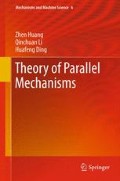Abstract
This chapter introduces our research on some dynamics problems of parallel mechanisms. The first problem is about the over-determinate inputs. This is quite an interesting issue. In practice, there are many machines and animals that work with over-determinate input, i.e., their input-number is much bigger than their mobility number. How to set the inputs to be accordance and optimum distribute and to obtain the expectant motion acceleration is a challenge. For the second part of this chapter, we focus on the dynamic analysis, i.e., the kinetostatic analysis of parallel mechanisms. For a link with two revolute pairs, based on its free-body diagram, its unknown value is 10 for the force analysis, and each link has only six equilibrium equations in the spatial mechanism. As it is, this is insolvable directly. Some time more unknown values may appear; and even up to 130 and it needs to set a 130-order matrix for the 5-5R parallel mechanism. This is extremely difficult. To resolve this issue, we propose a new method based on the screw theory. This method will only require the setting of a six-order matrix each time the dynamics problem can be readily solved. Moreover, in the following examples we can find the screws, their reciprocal screws, and their corresponding transformations each other, these are very interesting.
Access this chapter
Tax calculation will be finalised at checkout
Purchases are for personal use only
Notes
- 1.
If it does not need to calculate the constraint reactions of kinematic pairs, the active forces can be directly obtained by the principle of virtual work.
- 2.
If there are no external forces in limbs, Sects. 8.3.2.2 and 8.3.2.3 are not necessary.
- 3.
If not, there is no need to calculate the constraint reactions of pairs in limbs, and the active forces can be directly obtained by the principle of virtual work. When the forces of the main joints are solved, each limb becomes a serial-chain, and its force analysis would be simpler by directly setting the equilibrium of each body. However, we want to show that, by this method, the unknown number of equilibrium equations will not exceed six.
References
Huang Z, Zhao Y (1994) The accordance and optimization-distribution equations of the over-determinate inputs of walking machines. Mech Mach Theory 29(2):327–332
Huang Z, Kong L, Fang Y (1997) Mechanism theory of parallel robotic manipulator and control. China Mechanical Press, Beijing (in Chinese)
Huang Z (1985) Modeling formulation of 6-DOF multi-loop parallel manipulators, Part-1: Kinematic influence coefficients. In: Proceedings of the 4th IFToMM international symposium on linkage and computer aided design methods, vol. II-1, Bucharest, Romania, pp 155–162
Huang Z (1985) Modeling formulation of 6-DOF multi-loop parallel manipulators, Part-2: Dynamic modeling and example. In: Proceedings of the 4th IFToMM international symposium on linkage and computer aided design methods, vol. II-1 Bucharest, Romania, pp 163–170
Beyer R (1960) Statics and dynamics in 3-D mechanisms. Transactions of the 6th conference on mechanisms, Purdue University, West Lafayette, pp 94–112
Yang AT (1965) Static force and torque analysis of spherical four-bar mechanisms. ASME J Eng Ind Ser 87(2):221–227
Asada H, Slotine JJE (1986) Robot analysis and control. Wiley, New York
Merlet JP (2006) Parallel robots, 2nd edn. Springer, Paris
Zhang D, Gosselin CM (2001) Kinetostatic modeling of n-DOF parallel mechanisms with passive constraining leg and prismatic actuators. Trans ASME J Mech Design 123(3):375–381
Lu Y (2007) Using virtual work theory and CAD functionalities for solving active and passive force of spatial parallel manipulators. Mech Mach Theory 42(7):839–858
Zhou Y, Liu L, Gao F (2008) Full static solving of 3-DOF spherical parallel mechanism 3-RRR. Chinese J Mech Eng 44(6):169–176
Zhao Y, Huang Z (2010) Force analysis of lower-mobility parallel mechanisms with over-constrained couples. J Mech Eng 46(5):15–21
Huang Z, Zhao Y, Liu JF (2010) Kinetostatic analysis of 4-R(CRR) parallel manipulator with overconstraints via reciprocal-screw theory. Adv Mech Eng, Article ID 404960:1–11
Timoshenko SP, Gere JM (1961) Theory of elastic stability, 2nd edn. McGraw-Hill, New York
Liu H (2004) Mechanics of materials. Higher Education Press, Beijing
Author information
Authors and Affiliations
Rights and permissions
Copyright information
© 2013 Springer Science+Business Media Dordrecht
About this chapter
Cite this chapter
Huang, Z., Li, Q., Ding, H. (2013). Dynamic Problems of Parallel Mechanisms. In: Theory of Parallel Mechanisms. Mechanisms and Machine Science, vol 6. Springer, Dordrecht. https://doi.org/10.1007/978-94-007-4201-7_8
Download citation
DOI: https://doi.org/10.1007/978-94-007-4201-7_8
Published:
Publisher Name: Springer, Dordrecht
Print ISBN: 978-94-007-4200-0
Online ISBN: 978-94-007-4201-7
eBook Packages: EngineeringEngineering (R0)

